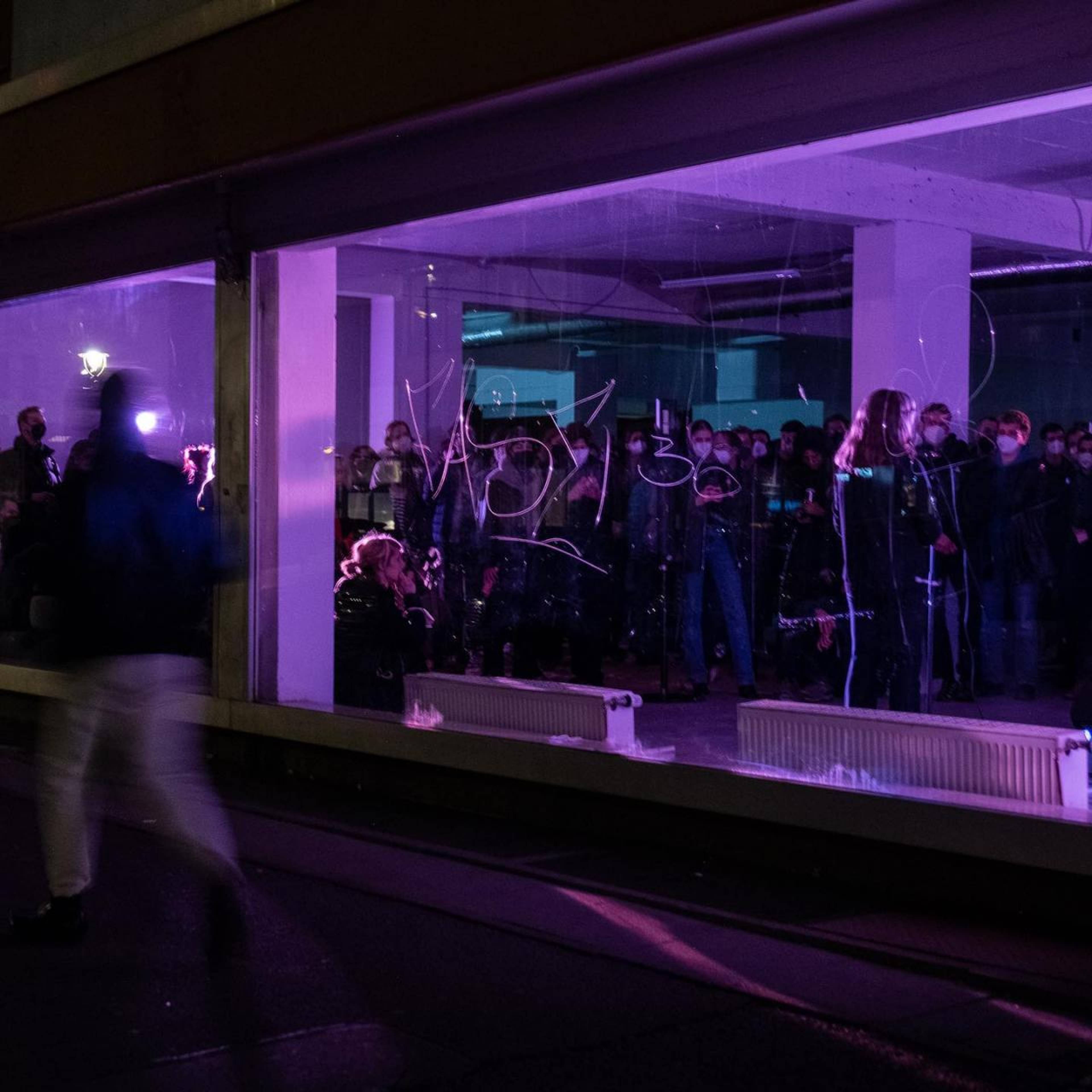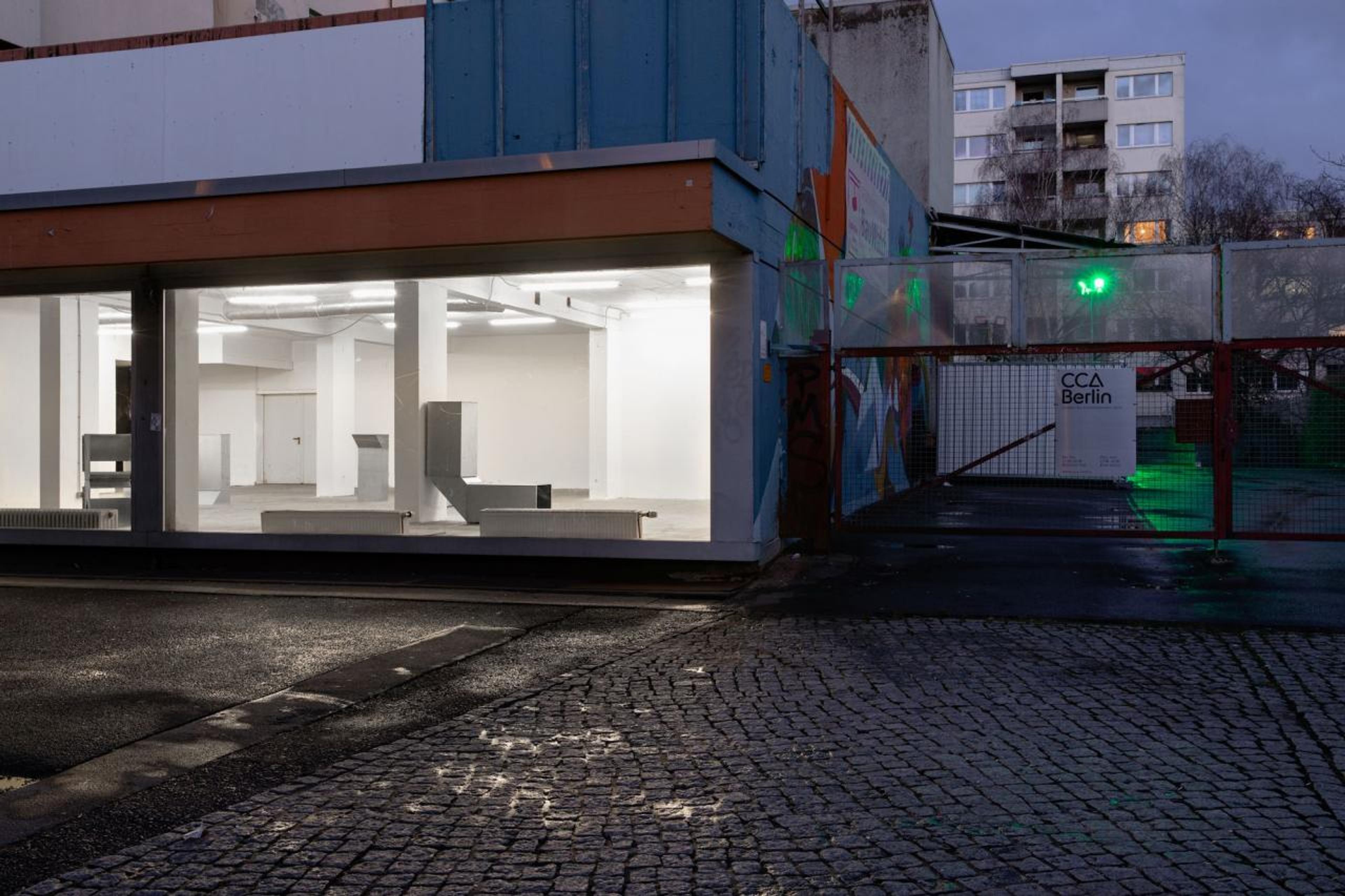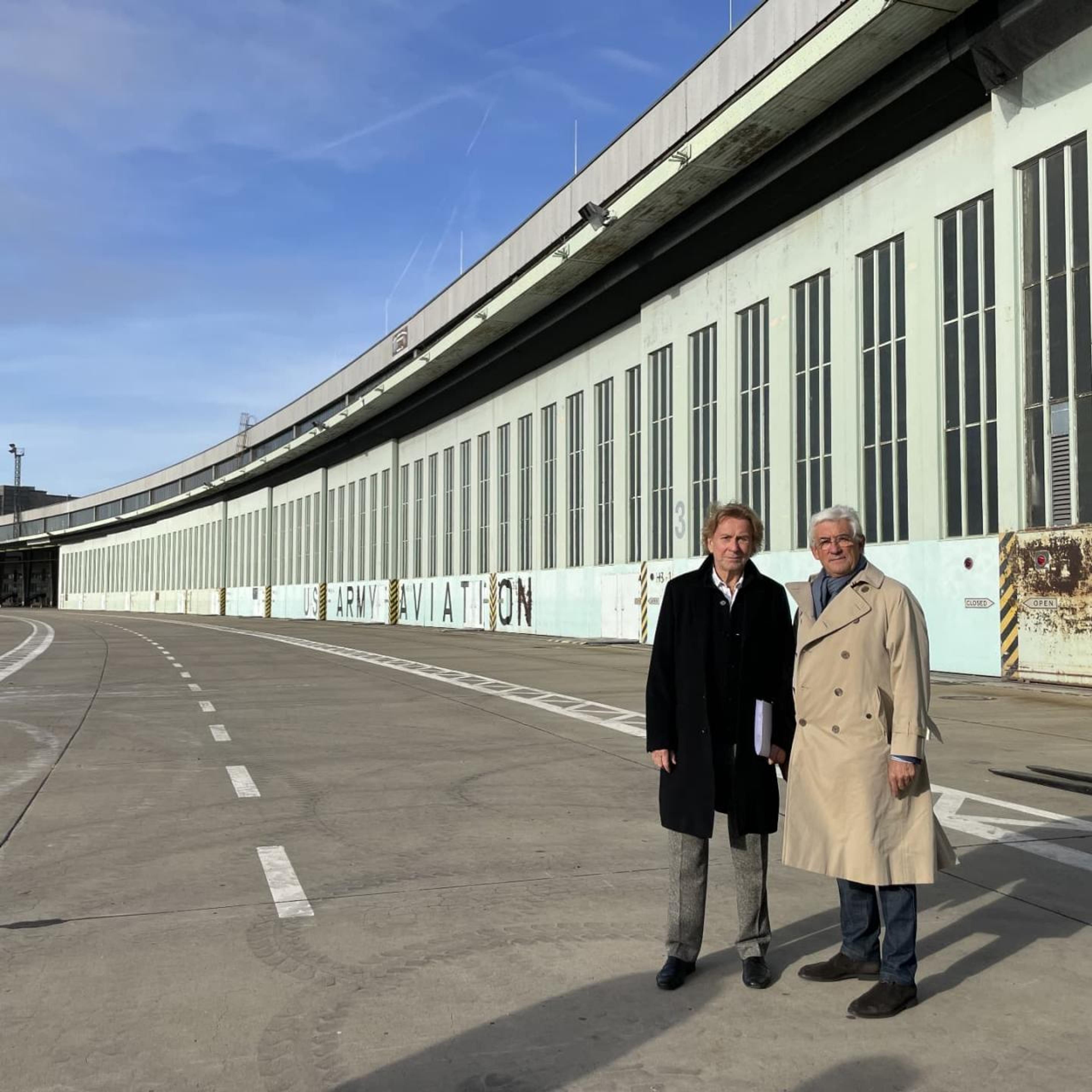The galvanised objects from the series “Square Tubes [Series D]” (1967), the most famous group of works by the artist Charlotte Posenenske, who died in 1985, stand around somewhat forlornly. She had already left the art world in 1968 to study sociology. Posenenske’s conclusion at the time was that artistic work could not bring about social change. A few years ago, she was honoured with an extensive retrospective at the Dia Art Foundation in New York. Her works are represented in many prominent collections (Daimler, Deutsche Bank) and have been shown extensively in Berlin, where Mehdi Chouakri Gallery manages her estate. Recently, for example, they could be seen in the show “Ways of Seeing Abstraction” in the Palais Populaire, the exhibition house of the Deutsche Bank, which closed in February. Nevertheless, Posenenske's work is the flagship first presentation in a twelve-month “pilot project” with which the Center for Contemporary Art Berlin (CCA), founded by Fabian Schöneich, recently launched their programme. (Not that there isn’t already a “centre for contemporary art” with a distinctly Berlin flavour in the form of the KINDL – housed in the giant complex of the former Kindl brewery, developed by the Basel collector couple Salome Grisard and Burkhard Varnholt.)
The new CCA’s founding director, Fabian Schöneich – who once worked at Portikus in Frankfurt – sees himself and his colleagues Sandra Teitge and Edwin Nasr as being on a par with the CCAs in Lagos and Singapore. In conversation, he even draws a comparison with the ICA in London, founded in 1946: at the time, certainly an institutional pioneering act in the British capital, which was largely cut off from developments in modern art. The way Schöneich sets up his project sounds worldly and testifies to high standards. This is probably also reflected in the international advisory board, which – like many things in this new foundation – is still in the process of being set up. According to a press release, Ruba Katrib (curator, MoMA PS1), the British-Lebanese artist Lawrence Abu Hamdan, and the entrepreneur Leopold Oetker (a shareholder of the Swiss food company Hero Group, known for Schwartau jams, among other products) are already enlisted. In the future, CCA’s advisory board aims to be made up of one-third representatives from the arts, education and business; in addition to directing programming, it should also ensure the institution’s long-term financial viability. Instead of founding an association (for example), the founder of the CCA has opted for the model of a non-profit LLC. Schöneich says he has partly acquired the necessary start-up capital, and partly raised it himself. While it’s nominally “non-profit” and the brand essence is “something with art”, and thus there is no profit in the commercial sense, salaries, rent, and perhaps also an operating budget still have to be earned: a problem that naturally arises in principle with every new institutional foundation. This is another reason why the CCA’s first year is defined as a “pilot year” in which, in addition to exploring temporary curatorial working methods, a circle of supporters is to be established.
Exterior of CCA Berlin. Inside: installation view of Charlotte Posenenske, “ Vierkantrohre Serie D”
Much is accordingly provisional at the Berlin CCA – including its current location at the corner of Potsdamerstraße and Kurfürstenstraße. As the northern section of the “Potse” has become an attractive corridor lined with galleries and art-world haunts like TV Bar, the neighbouring streets are being rapidly developed with exclusive new construction projects. In a neighbourhood where sex workers pursue their trade under visibly precarious conditions, the CCA shares a vacant former furniture shop with a commercial gallery, Heidi, founded in September of last year by Pauline Seguin, who had previously worked at Gavin Brown’s Enterprise in New York. The temporary proximity between a commercial gallery and an institution in search of meaning that wants to “reformulate the relevance of a non-profit centre for contemporary arts” and strives for “a lively, transnational dialogue with actors from the cultural, educational and civil society sectors” sounds like a win-win situation, with a picturesque Kiez-Flair .
But at the end of the year, it will be over again. With this, the marriage of convenience – separated only by a curtain on site – indicates, above all, that free space for art in Berlin has been largely exhausted. It seems that even those segments that see themselves as international avant-garde are now dependent on temporary use and provisional solutions – formerly the hallmarks of the Freie Szene often ridiculed by the official art establishment. CCA’s programme also points in this direction when it pragmatically extends outward into the neighbourhood, planning events at the neighbouring Twelve Apostles Church and cooperations with the UdK class taught by performance artist Jimmy Robert, where Posenenske’s works serve as “props” to be “reconfigured” by participants.
Walter Smerling and Bernar Venet at Tempelhof, 2021
Another newly-founded institution, the so-called “Kunsthalle Berlin”, has attracted a great deal of media attention and downright anger from the art scene. In contrast to its official name, this purely private initiative opened at the end of January in Hangars 2 and 3 of the former Tempelhof Airport with a retrospective of the French installation artist Bernar Venet. The sponsor of the “Kunsthalle” is a private association founded in 1986 and based in Bonn, Rhineland, which calls itself the “Stiftung für Kunst und Kultur e.V.”. Its chairman is the former TV journalist and current “cultural manager” and curator Walter Smerling. Born in Bad Godesberg in 1958, Smerling tackles what is too banal for most others in the field. In doing so, however, he fills the huge gap that exists between the art scene and the mainstream: he serves the needs of audiences who conceive of art as something that hangs beautifully on the wall, stands around decoratively, and need not be too complicated as long as it has a prominent name on it.
Baselitz, Kiefer, Lüpertz, and now Venet, are accordingly Smerling’s favourite artists. He is particularly popular with dubious major collectors, such as the construction magnate Hans Grothe, who died in 2019 and who, with Smerling’s active help, once had his collection upgraded by public institutions such as the Art and Exhibition Hall of the Federal Republic of Germany in Bonn, as well as greying political and business leaders from the old FRG elite. It is fitting that the ex- Bild editor-in-chief and current PR consultant Kai Diekmann sits on the board of Smerling’s association. Among other things, Smerling runs a private museum in Duisburg, the Ströher Collection, and in recent years has already made several appearances as the organiser of controversial “major” exhibitions in Berlin and elsewhere.
“60 Years, 60 Works” (2009) at Martin Gropius Bau in Berlin, for example, ostentatiously hushed up the East German part of recent German art history, met by celebratoy reception from the tabloid Bild . For the exhibition “Deutschland 8” (2017) in Beijing, Smerling brought the arms company Rheinmetall on board as a sponsor, spurring several of the participating artists, including Hito Steyerl, Rosemarie Trockel and Clemens von Wedemeyer, to react with a letter of protest. The inglorious history of the “Kunsthalle Berlin” also includes the fact that Smerling was able to hold the large-scale exhibition “Diversity United” in the Tempelhof hangars in the summer of 2021 as a predecessor project to the current “Kunsthalle” – with Vladimir Putin and Federal President Frank-Walter Steinmeier, of all people, as patrons. A second iteration of the show then travelled last November to the State Tretyakov Gallery in Moscow, which had to close its doors prematurely when Russia, in violation of international law, began its war of aggression on Ukraine.
The massive protests that Smerling attracted with his invention of a “Kunsthalle Berlin” have receded into the background in view of the humanitarian catastrophe the war has caused. But the criticism aimed at projects helmed by the “Stiftung für Kunst und Kultur e. V.”, which have been supported by political and business leaders for too long – largely unnoticed in the art world – is as overdue as it is justified. As the Frankfurter Allgemeine Zeitung first revealed, the City of Berlin is letting the cultural entrepreneur use the two halls, a total of 8,000 square metres, rent-free for two years, in addition to contributing around 100,000 euros a month towards the operating costs. Even established Berlin institutions can only dream of annual subsidies of up to 1.2 million.
The increasingly scarce public spaces in this city lie fallow, or are given away for private interests, without any real benefit to artists or the broader public.
The state and federal governments’ lack of plan and concept in cultural policy can be seen nowhere more clearly than in Tempelhof. The increasingly scarce public spaces in this city lie fallow, or are given away for private interests, without any real benefit to artists or the broader public. “We demand that Berlin’s cultural policy finally takes art and the art scene seriously and stops trying to compensate for the chronic underfunding of existing institutions by relying on private players. The interested public and professional expertise must be involved through proper procedures, instrumentalisation must be prevented. We demand that public funds be used directly for artists and public institutions without middlemen.” This is what the authors of an open protest letter dated 16 February 2022 wrote, demanding something that is actually self-evident. They are thus part of a long tradition of artistic resistance against ignorance in official cultural policy. A glance at the already historic manifesto “ Haben und Brauchen ” (To Have and to Need), with which Berlin artists resisted the founding of a Kunsthalle meant to art-wash the Europacity real estate project in 2011, reveals as much. This history makes the droning silence from Berlin’s federal and state politicians, who do not face up to their responsibility and do not seem to be willing to learn anything from their own history in this regard, all the more significant.
Where politicians show little interest in development, investors are readily willing to step in. Unlike in the exemplary case of Smerling, it is not always so clear with what aim and by what means. In Wedding, for example, a veritable gentrification triangle has been established during the past two pandemic years, ever since the privately financed Callie’s studio centre opened its doors in a converted former vault factory, situated between the SAVVY Contemporary project space and the Silent Green cultural quarter (aptly located in a former crematorium). What sounds like a cute cupcake factory is in fact a “non-profit experimental institution” similar to the CCA, offering a studio and residency programme for artists from various fields. A further similarity to the CCA is its business form, as a non-profit LLC. Callies’ large studio and exhibition complex, situated around an inner courtyard, is led by Jarrett Gregory, a Berliner by choice who, after working at the Hirschhorn Museum in Washington, the LACMA in Los Angeles, and the New Museum in New York, now works full-time as a curator at the Fondation Beyeler in Basel.
Exterior of Callie’s, Berlin. Photo: Nick Ash
What is striking about Callie’s is that many of its prominent residents, from Rosa Barba and Candice Breitz to Andro Wekua and Peter Wächtler – along with, currently, Camille Henrot and Peaches – already live and work relatively successfully in Berlin anyway. On the other hand, Callie’s is also open to artists who work in music, dance, and performance – i.e., in the fluid field between commercial club and subsidised festival culture – such as Isabel Lewis, Mouse on Mars, Marcin Pietruszewski, and Phillip Sollmann. “The idea of a residency-based programme emerged from both research and conversations I had with artists in Berlin about what kind of space and support they needed”, Jarrett Gregory tells us in an email. “I have a lot of experience with the traditional dynamic between artists and museums, and I wanted to rethink how institutions could support artists at all stages of their careers, since I believe there is a lot more to be done than making exhibitions. From my early days in Berlin, I knew I wanted to create an institution that addressed a specific need: in this case, the space and time to think and experiment, with a special focus on less saleable practices, like performance. Specifically, Callie’s identifies as a non-transactional space: we don’t ask for anything from artists; there are no fees, no requirements to participate in programming, or to produce anything. My impression is that artists are depleted these days. Callie’s is conceptualised not only as a repair, but as an experiment to see how we can start working differently.” After two years of purely privately financed existence, the cultural production house is currently applying for public subsidies for the first time. “I think it's important that Callie's build a hybrid funding structure,” Gregory writes in the same e-mail. “Ideally, the combination of private and public funding will enable us to stay nimble in our programming and adapt to artists’ needs, while also grounded in a city with a vibrant arts ecosystem.”
Installation view of Phillip Sollmann and Konrad Sprenger, Modular Organ System , at Callie’s (2022).
Here, the future of art that the CCA is still looking for seems to have already settled down. From the internet presence to the on-site bookshop “artist’s proof”, a highly sensitive awareness of taste, expertise, cosmopolitanism, and refinement is visible. The art bookshop, with its offensively “curated” assortment of titles on radical art movements, counterculture, class struggle, and poetry, fits in perfectly with the new, gentrified sheen of “diversity” in Wedding. This offers some hope, but also does nothing to change the fact that even a “diverse” capitalism is still, first and foremost, “capitalism”. Of course, Callie’s wants to promote “creativity, cultural exchange, and cross-disciplinary collaboration” and at the same time be available for the “immediate community” in this long-neglected neighbourhood, historically populated by immigrants, around the Wedding S-Bahn station.
The rhetoric of neighbourly care, however, is framed by a flurry of construction activity that points to the well-known cycle of investment, gentrification and displacement. The owner of the land and buildings of the former factory complex Lindower 20–22 is the Italian fashion entrepreneur and art collector Francesco Dalla Rovere, who acquired the property a few years ago with the architect Flavio Albanese. On the website of the Berlin architects Heim Balb, commissioned to convert and extend the entire property, two separate projects are listed. On the one hand there is “ Berlin Cultural ”, i.e. Callie’s, described by the architects as “A new creative hub, featuring artist studios, flats and exhibition spaces ... sparingly renovated with the marks of time left visible, thus creating an atmosphere that inspires creativity.” Project number two, currently under construction on the other part of the site, is described as a “ Berlin Mixed-Use ”, planned as a “mix of studios, galleries, 35 residential units, bars, restaurants and a theatre” which will be “integrated into the existing historic structure to create a lively neighbourhood” . Theirs is an exemplary vision of a cultural centre for a capital city where land, property, and rent prices have been rising steadily for decades – despite the fact that social democracy rules and the top cultural politician is currently from the left. At the moment, apparently, no truly new answers to Berlin’s age-old problems are in sight.
Dub night with Bill Kouligas at Callie’s, 2021
KITO NEDO is a regular contributor to Süddeutsche Zeitung , frieze magazine , and art - Das Kunstmagazin . In 2017 he won the ADKV-Art Cologne Award for art criticism. He lives in Berlin and Basel.
HANS-JÜRGEN HAFNER is a writer, art critic and organizes exhibitions. H e is based in Berlin.







